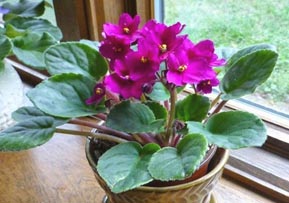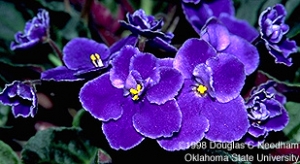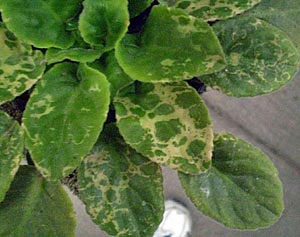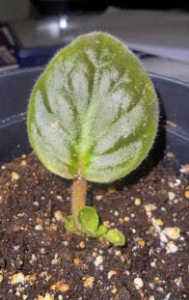Violets: Out of Africa
by Ray Novitske, Fairfax Master Gardener
 In 1892, Baron Walter von Saint Paul, the governor of German East Africa, came across some unusual flowers in the mountains near Tanga, in what is now Tanzania. These low-growing plants with hairy leaves and beautiful blue flowers were found growing among mosses in the shaded, moist rock ledges. Baron Walter sent samples to his father, a patron of a botanical garden near Hanover, Germany, who gave the samples to the garden’s botanist, Herman Wendland. Wendland recognized the plant as a new genus and named it Saintpaulia, in honor of its discoverer. In a year, African violets (Saintpaulia ionantha) were offered commercially in Europe and in America, destined to become one of our most popular houseplants.
In 1892, Baron Walter von Saint Paul, the governor of German East Africa, came across some unusual flowers in the mountains near Tanga, in what is now Tanzania. These low-growing plants with hairy leaves and beautiful blue flowers were found growing among mosses in the shaded, moist rock ledges. Baron Walter sent samples to his father, a patron of a botanical garden near Hanover, Germany, who gave the samples to the garden’s botanist, Herman Wendland. Wendland recognized the plant as a new genus and named it Saintpaulia, in honor of its discoverer. In a year, African violets (Saintpaulia ionantha) were offered commercially in Europe and in America, destined to become one of our most popular houseplants.
 Eventually, 21 species of African violets would be found in the wild – all of them in East Africa. Each has its own specific habitat, from wet mountains to soggy shade. Because African violets are easy to propagate and breed, many cultivars have been developed. Traits with unique colors, miniature size, double flowers, variegated foliage and “girl foliage” (scalloped edges) are now available. Colors range from white to dark purple, with blues, pinks and lavenders available, too.
Eventually, 21 species of African violets would be found in the wild – all of them in East Africa. Each has its own specific habitat, from wet mountains to soggy shade. Because African violets are easy to propagate and breed, many cultivars have been developed. Traits with unique colors, miniature size, double flowers, variegated foliage and “girl foliage” (scalloped edges) are now available. Colors range from white to dark purple, with blues, pinks and lavenders available, too.
African violets are one of our most popular houseplants because they easily grow indoors. Their native habitats are similar to the temperatures and light conditions found in our homes. But many indoor gardeners lament that these beauties will not bloom. According to the experts, the most likely reasons are improper light or improper temperatures.

Too much light causes leaf scorch and deformed leaves
African violets grow best with night temperatures of 65 to 70 degrees (18-21 C), which are similar to their equatorial African home, and day temperatures of around 80 degrees (26 CV). Cooler temperatures will cause deformation in the form of light-colored, cupped or downward-turned leaves, or flowers that are discolored or misshapen. In fact, many commercial greenhouses do not grow African violets because the temperature requirements are so different from most other greenhouse plants.
Incorrect lighting, however, is probably the main reason that African violets fail to bloom. They need six to eight hours of bright light per day, equivalent to a sunny east or west window. North windows may not provide enough light, and south windows may provide too much. Shear curtains can serve to filter sunlight in a south window or during summers when sunlight is more intense. Insufficient light causes leaves to darken and creates long petioles on the leaves. Fluorescent lights work well to provide supplemental light. Too much light, however, results in stunted plants or plants with bleached or small crinkled leaves.

Water on leaves causes spots
High humidity will benefit African violets, as it does in their natural habitat, although the plants can do well in homes with average humidity. Placing pots in a shallow tray with water and pebbles or gravel keeps up the humidity. Be careful, though, with this method: Use of the tray should not contribute to soggy soil.
Allow soil to become slightly dry between waterings. Splashing the leaves with water, especially cold water, can cause spots and discoloration. Room-temperature water works best. All plants should be watered at least occasionally from the top to leach salts that can accumulate in the soil.

African violet leaf propagation
African violets have a very fine root system and benefit from a light, loose and well-drained soil mix with a high content of organic matter. It is important that the soil allows air and water to move through, and that it is not kept soggy or saturated. “Generally avoid bagged mixes sold for houseplants or African violets, as these often have heavy black peat (decomposed peat moss) which holds too much water and too little air,” writes Leonard Perry, Extension Professor at University of Vermont Extension.
The easiest way to propagate plants is by rooting leaves. To do so, place a leaf petiole in a rooting medium such as vermiculite or sand. When kept moist, the leaf petiole will develop a new plant at its base in about four to six weeks. Sometimes placing the petiole in only water will work.
When choosing an African violet, you can select from the hundreds of cultivars now available. Just remember that giving African violets a home environment mimicking their natural habitat should ensure blooming success.
References
Growing African Violets, Paul A. Thomas, Extension Horticulturist, University of Georgia Extension
African Violet Care, Rosie Lerner and Michael N. Dana, Purdue University Cooperative Extension Service
African Violets: Seven Steps for Success, Dr. Leonard Perry, University of Vermont Extension
African Violet Society of America
…updated 2022